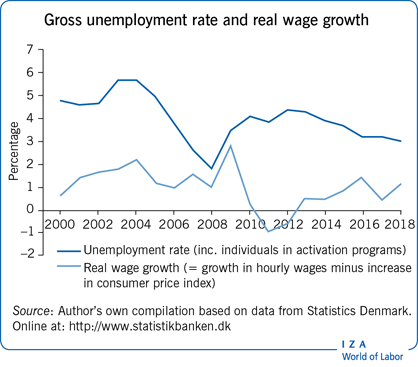Elevator pitch
Denmark is often highlighted as a “flexicurity” country characterized by lax employment protection legislation, generous unemployment insurance, and active labor market policies. Despite a sharp and prolonged decline in employment in the wake of the Great Recession, high job turnover and wage adjustments worked to prevent increased long-term and structural unemployment. Most unemployment spells were short, muting the effects on long-term and youth unemployment. Recent reforms boosted labor supply and employment, targeting the young, elderly, and immigrants. Employment recovered to its structural level around 2015 and has since increased due to a favorable business cycle situation and structural reforms (particularly increases in retirement age).

Key findings
Pros
Employment rates recovered after the crisis; employment has been increasing in recent years due to cyclical factors and structural reforms.
No significant increase has been observed in long-term unemployment and youth unemployment has remained relatively low.
High job turnover rates ensure that most unemployment spells are short, which helps prevent a rise in structural unemployment.
Wage adjustment has been flexible and wage competitiveness has recovered since the crisis.
There are few working poor due to high minimum wages and a compressed wage structure.
Cons
A large share of youths enters the labor market with low qualification levels; this is especially challenging because there are few low-skilled jobs.
Immigrants from low-income countries have low employment rates.
Job turnover may be excessively detrimental to human capital accumulation.
Wage inequality is moderately widening.
Average working hours are low.